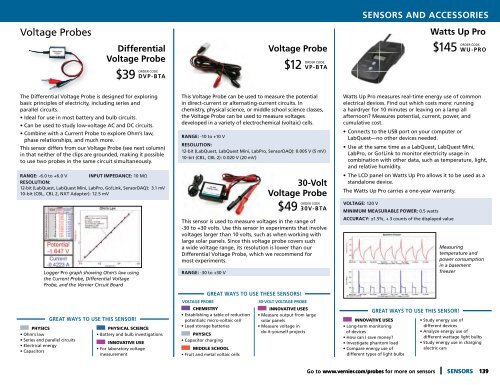Download - Amazon Web Services
Download - Amazon Web Services
Download - Amazon Web Services
Create successful ePaper yourself
Turn your PDF publications into a flip-book with our unique Google optimized e-Paper software.
Voltage Probes<br />
PHYSICS<br />
• Ohm’s law<br />
• Series and parallel circuits<br />
• Electrical energy<br />
• Capacitors<br />
differential<br />
voltage Probe<br />
$39<br />
range: -6.0 to +6.0 V inPut imPedance: 10 MΩ<br />
resolution:<br />
12-bit (labQuest, labQuest Mini, labPro, go!link, SensorDaQ): 3.1 mV<br />
10-bit (cBl, cBl 2, nXt adapter): 12.5 mV<br />
Logger Pro graph showing Ohm’s law using<br />
the Current Probe, Differential Voltage<br />
Probe, and the Vernier Circuit Board<br />
great Ways to use tHis sensor!<br />
PHYSICAL SCIENCE<br />
• Battery and bulb investigations<br />
INNOVATIVE USE<br />
• For laboratory voltage<br />
measurement<br />
orDer coDe<br />
dvP-bta<br />
the Differential Voltage Probe is designed for exploring<br />
basic principles of electricity, including series and<br />
parallel circuits.<br />
• Ideal for use in most battery and bulb circuits.<br />
• Can be used to study low-voltage AC and DC circuits.<br />
• Combine with a Current Probe to explore Ohm’s law,<br />
phase relationships, and much more.<br />
this sensor differs from our Voltage Probe (see next column)<br />
in that neither of the clips are grounded, making it possible<br />
to use two probes in the same circuit simultaneously.<br />
CHEMISTRY<br />
• Establishing a table of reduction<br />
potentials: micro-voltaic cell<br />
• Lead storage batteries<br />
PHYSICS<br />
• Capacitor charging<br />
great Ways to use tHese sensors!<br />
MIDDLE SCHOOL<br />
• Fruit and metal voltaic cells<br />
voltage Probe<br />
$12<br />
orDer coDe<br />
vP-bta<br />
this Voltage Probe can be used to measure the potential<br />
in direct-current or alternating-current circuits. in<br />
chemistry, physical science, or middle school science classes,<br />
the Voltage Probe can be used to measure voltages<br />
developed in a variety of electrochemical (voltaic) cells.<br />
range: -10 to +10 V<br />
resolution:<br />
12-bit (labQuest, labQuest Mini, labPro, SensorDaQ): 0.005 V (5 mV)<br />
10-bit (cBl, cBl 2): 0.020 V (20 mV)<br />
30-volt<br />
voltage Probe<br />
$49<br />
orDer coDe<br />
30v-bta<br />
this sensor is used to measure voltages in the range of<br />
-30 to +30 volts. Use this sensor in experiments that involve<br />
voltages larger than 10 volts, such as when working with<br />
large solar panels. Since this voltage probe covers such<br />
a wide voltage range, its resolution is lower than our<br />
Differential Voltage Probe, which we recommend for<br />
most experiments.<br />
range: -30 to +30 V<br />
voltage Probe 30-volt voltage Probe<br />
INNOVATIVE USES<br />
• Measure output from large<br />
solar panels<br />
• Measure voltage in<br />
do-it-yourself projects<br />
voltage: 120 V<br />
sensors and accessories<br />
minimum measurable PoWer: 0.5 watts<br />
accuracy: ±1.5%, + 3 counts of the displayed value<br />
Watts up Pro<br />
orDer coDe<br />
Wu-Pro<br />
watts Up Pro measures real-time energy use of common<br />
electrical devices. find out which costs more: running<br />
a hairdryer for 10 minutes or leaving on a lamp all<br />
afternoon? Measures potential, current, power, and<br />
cumulative cost.<br />
• connects to the USB port on your computer or<br />
labQuest—no other devices needed.<br />
• Use at the same time as a labQuest, labQuest Mini,<br />
labPro, or go!link to monitor electricity usage in<br />
combination with other data, such as temperature, light,<br />
and relative humidity.<br />
• the lcD panel on watts Up Pro allows it to be used as a<br />
standalone device.<br />
the watts Up Pro carries a one-year warranty.<br />
great Ways to use tHis sensor!<br />
INNOVATIVE USES<br />
• Long-term monitoring<br />
of devices<br />
• How can I save money?<br />
• Investigate phantom load<br />
• Compare energy use of<br />
different types of light bulbs<br />
$145<br />
Measuring<br />
temperature and<br />
power consumption<br />
in a basement<br />
freezer<br />
• Study energy use of<br />
different devices<br />
• Analyze energy use of<br />
different wattage light bulbs<br />
• Study energy use in charging<br />
electric cars<br />
go to www.vernier.com/probes for more on sensors- |- |- sensors<br />
139


